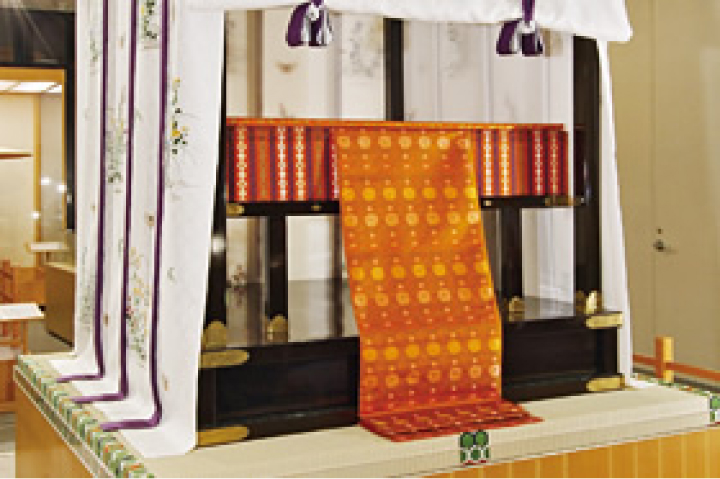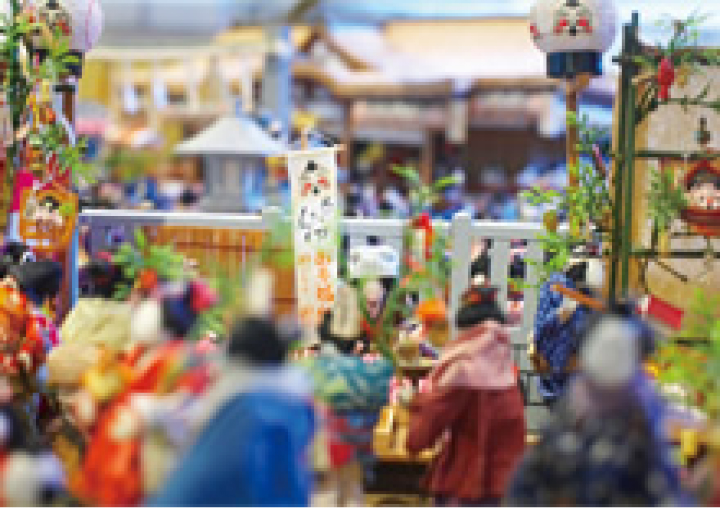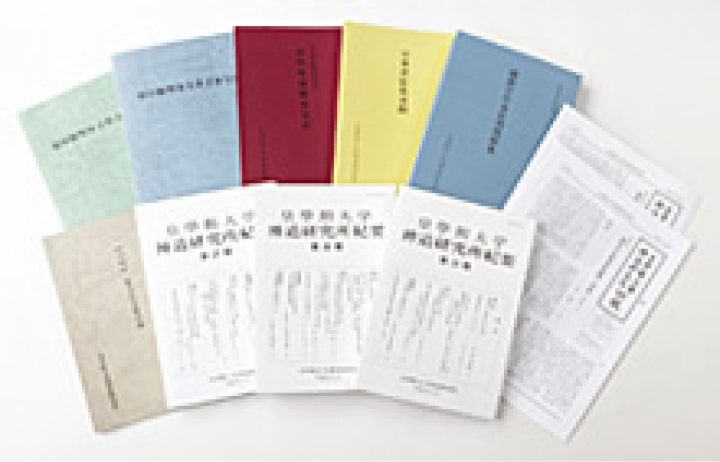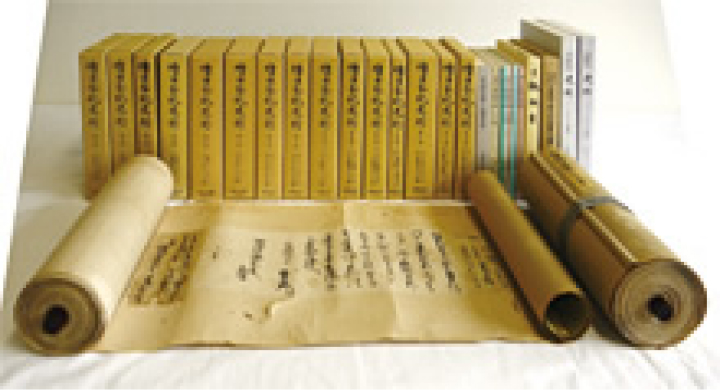Research and Development Center
Research and Development Center
This center is an integrative organization that is consisted of the following three institutes: Shinto Institute, Historiographical Institute, and Sagawa Memorial Museum of Shinto and Japanese Culture. It also plans, promotes, and develops university-wide research projects and publish the study achievements.
In order to meet the new research and educational functions that are expected by the society, this center crystallizes and strengthens the school philosophy for future years.

Sagawa Memorial Museum of Shinto and Japanese Culture
A Treasury of Reference Materials regarding Shinto and Japanese Culture that is Open to the Public as a Place for Lifelong Learning
This memorial museum stores and exhibits a large number of materials regarding Shinto, eg, Shinto festival utensils and food offerings, reference materials of traditional Japanese culture and history related to Shinto. By introducing Shinto and Shinto shrines that are the sources of history and culture of Japan, this museum acts as a facility to promote accurate understanding of Japanese traditions, faith, and philosophy that have been inherited in an unbroken line from ancient times. In particular, Ise is the place where a Shinto shrine referred to as Ise Jingu (Grand Shrine of Ise) solemnly sits. This shrine is considered to be "spiritual home of the Japanese." Many precious cultural assets and properties are scattered around Ise Jingu. Not only these local historical materials, this museum also actively promotes collection, storage, research and study, exhibition of Shinto-related materials, and educational activities to increase public awareness regarding shrines and Shinto. This museum provides researchers and students with archives and a variety of information, while trying to enhance further functions in order to promote local culture by being a place for lifelong learning.

| Archives, Publications, and Video Materials | |
|---|---|
| ①Shinto | Materials and documents regarding Shinto festivals and special food offerings handed down in each shrine, based on reference materials for understanding of Shinto and shrines |
| ②Local Culture and History | Reference materials related to local culture and history, including those of Ise Kabuki and archaeological materials |
| ③Kogakkan (exhibited in the Memorial Hall) | Various reference materials related to Kogakkan University |
| ④Reference materials related to the collection of the Obara Family Library | Materials including pictures, drawings, and documents from Kyoto, the Dairi (the Imperial Palace), and Daijo-sai (the Great Harvest Ritual performed by Emperors after their Enthronement) as well as the accession ceremonies of the Taisho/Showa Eras collected by Toshiyasu Obara |
| ⑤Other Materials | Various reference materials related to Japanese history, culture, and folk culture Classical books and calligraphy of scholars of Japanese classical literature, Kaishi (Japanese traditional paper sheets) and Tanzaku (strips of paper) for Waka poems, and picture materials based on Japanese Yamato-e paintings |
| ⑥Library and Video Materials | Publications regarding Shinto, museology, Japanese history, and history of Japanese art surveys and research reports, magazines, catalogs and pictorial records of various exhibitions photos and videos regarding Shinto |
Shinto Institute
From advanced research and transmission of research achievements to cultivation of young researchers, this institution functions as a base for the study of Shinto.
Shinto Institute was founded in 1973 as an institute belonging to Faculty of Literature. In 1978 its functions were expanded as an independent institute belonging to the university. Descending from the historic flow of this university’s foundation for training Shinto priests, this institute develops highly-advanced academic study regarding Shinto. Its activities are broadly divided into general research and specific research. General research focuses on the following three themes: Daijo-sai (the Great Harvest Ritual performed by Emperors after their Enthronement), Enryaku-gishiki-cho (register of ceremonies), and Ise Jingu (Grand Shrine of Ise). On the other hand, specific research has the following five themes regarding Shinto: philosophy, festivals, history, religion/folk culture, and literature/art. The research accomplishments are sent out in the form of written publications. This institute makes a devoted effort to cultivate and nourish younger researchers and also accept those from abroad. Moreover, by holding symposiums and lecture presentations, this institute develops its activities on a broad perspective as a base for the study of Shinto.

| General Research | |
|---|---|
| ①Study of Daijo-Sai (the Great Harvest Ritual performed by Emperors after their Enthronement) |
Daijo-sai festival is held as an important ceremony only once in the reign of each emperor when the emperor is enthroned. Studying Daijo-sai contains important study issues in order to learn Japanese culture and the traditions of the spiritual life of the Japanese people. |
| ②Study of Enryaku-gishiki-cho (Register of Ceremonies) |
This study tries to read and interpret the oldest and most important classic book of Ise Jingu, and Enryaku-gishiki-cho (register of ceremonies). |
| ③General Study of the Ise Jingu (the Great Shrine of Ise) |
This study focuses on Shinto festivals, Sengu (shrine transfer), and Ise Shinto. As part of the study of Jingu festivals, this study also aims to collect reference materials, study various ceremonies and events, and promotes the building of a database. |
| Specific Research | |
|---|---|
| ①Philosophy of Shinto | Research on Shinto priests and scholars of Japanese history in the early modern period according to each era. |
| ②Festivals | Research on the rituals, services, ceremonies and festivals of Shinto conducted by the imperial court, Jingu shrines, and shrines across the nation. |
| ③History of Shinto | Research on the history of Shinto from the ancient times to modern days. It focuses especially on Ise Jingu and faith in Ise Jingu, along with issues between the state and religions in early modern Japan. |
| ④Religion and Folk Culture | Reseaech on the religious aspects of Shinto, and relationship between Shinto and folk culture. |
| ⑤Literature and Art | Research on the relationships between literature and arts, and Shinto. Particularly, it focuses on research of Shinto classics and analysis of Shinto related vocabulary. |
Historiographical Institute
Editing and collecting historical materials to study the history and culture of Japan,
mainly on Shoku Nihon-gi (Continuation of the Chronicles of Japan) and historical materials of the Ise Jingu
Formerly this institute was founded as a research institute belonging to the Department of National History in 1975. In 1978 this institute become an independent institute belonging to the university. Since then, its research functions have been enhanced further. The purpose of this institute is to collect, study, and edit historical materials that are necessary for studying the history and culture of Japan, and to make contributions to development of this academic subject. Currently, this institute has the following four sections which conduct research and editing based on their own themes. The archives of this institute consist of a library, survey reports, magazines regarding national history, various photocopies of Shoku Nihon-gi (Continuation of the Chronicles of Japan), photocopies of those old copies of laws of codes and ethics, a collection from the Fukutomi Family Library, and contributed documents.

| Study Departments | |
|---|---|
| ①Six-country chronological historical materials | Editing of historical materials of Shoku Nihon-gi (Continuation of the Chronicles of Japan) |
| ②Historical materials of Ise Jingu | Editing of the historical materials of Ise Jingu and Oshi (Jingu priests) |
| ③Historical materials of the Meiji Era | Classification and editing of the Kagawa Family Library |
| ④Historical materials of archaeology | Classification and editing of the archives of literary remains offered by Mr. Toshio Suzuki |
[Major Publications]
- "Shoku Nihon-gi Shiryo" (Historical materials of the Continuation of the Chronicles of Japan),
Vol. 1 through Vol. 17 - "Jingu Oshi Shiryo" (Reference materials of Jingu priests), Collection 1 through Collection 7
- "Suzuki Toshio-shi Iko and Kyuzou Shiryo Mokuroku"
(Literary remains offered by Mr. Toshio Suzuki and a bibliography of old archives) (Original and sequel) - "Fukutomi-ke Monjo - Nozubon <Hojo Keizu and Ohtomo Keizu>"
(A collection of the Fukutomi Family Library: Nozu books
- "Genealogy of the Hojo Family and Genealogy of the Otomo Family"), and others - "Kagawa Keizo Kankei Shiryo no Sekai" (The World of the Historical Materials related to Keizo Kagawa)
- "Shiryo" (Historical Materials), reprinted editions from No. 1 to No. 150
- "Zoho, Momo no Kakiha - Shikida Toshiharu Shokanshu Oyobi Kankei Bunsho - "
(Enlarged edition of Momo no Kakiha - Collection of Letters of Toshiharu Shikida and Related Documents),
and others
